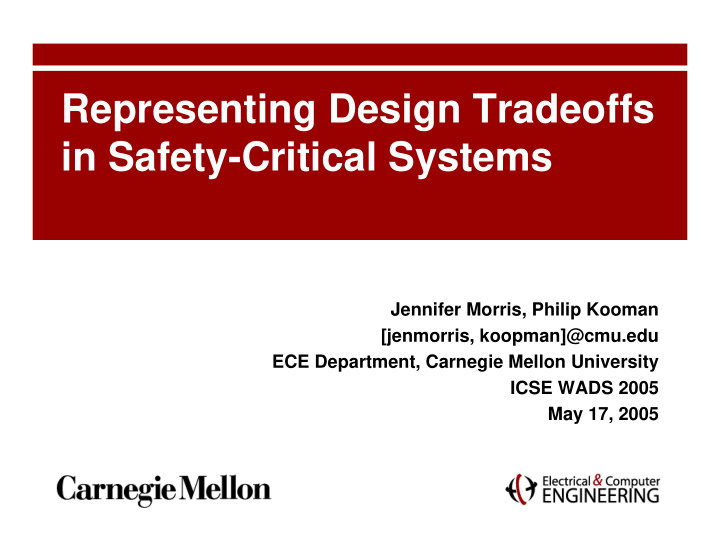



Representing Design Tradeoffs in Safety-Critical Systems Jennifer Morris, Philip Kooman [jenmorris, koopman]@cmu.edu ECE Department, Carnegie Mellon University ICSE WADS 2005 May 17, 2005
Motivation • Increased reliance on software in safety-critical systems • Effective strategies in place for some application domains – Aviation: • Fail-operational with triple modular redundancy – Rail: • Fail-stop with two-of-two systems • Fail-operational with dual two-of-two systems • Can we apply these techniques to new application domains and achieve the same results? • Which techniques should we choose? – For example, should we build x-by-wire cars like fly-by-wire planes? 2
Graphical Tools for Comparing Application Domains • Kiviat graphs [Kolence & Kiviat ‘73, Esponda and R. Rojas ’92] – “Spider Plot” – Used to compare software performance – Various system metrics plotted on multiple axes CPU & Channel Performance – Profile used for comparison with other systems CPU & Channel Performance CPU busy CPU busy CPU Only busy CPU not busy CPU Only busy CPU not busy CPU & Channel Busy Channel Busy CPU & Channel Busy Channel Busy Channel Busy & CPU not Channel Busy & CPU not 3 Busy Busy
Rail Systems Switching & Signalling Vehicle 10 7 10 6 System Cost ($) (BART upgrade $45 million) (BART car $2 million) Production 10 3 10 5 10 10 10 11 ~Market Size ($) (Tens of $ billions) (Hundreds of $ billions) Mission Time 10 5 10 2 (hours) (Tens of years) (Several days) Dispatchability 10 3 10 3 (~ .1-.2% failed at dispatch) (~ .1-.2% failed at dispatch) 10 9 10 6 MTTF (hours) (~100,000 years) (~100 years) Fault-Tolerance Dual fail-stop 2-of-2 systems Fail-stop 2-of-2 system Strategy 4
5 Rail Systems
Aviation Flight Control & Automotive Steering Aviation Flight Control Automotive Steering 10 8 10 4 System Cost ($) (Hundreds of $ millions) (Tens of $ thousands) Production 10 3 10 7 10 11 10 11 ~Market Size ($) (Hundreds of $ billions) (Hundreds of $ billions) Mission Time 10 1 10 1 (hours) (Several hours) (Several hours) Dispatchability 10 3 10 4 (~.1-.2% failed at dispatch) (~.01-.02% failed at dispatch) 10 9 10 9 MTTF (hours) (~100,000 years) (~100,000 years) Fault-Tolerance Triple modular redundancy Duplex modular redundancy Strategy (?) 6
7 Aviation Flight & Automotive Steering Control
What do We Observe? • Rail signaling & switching vs. vehicle – S & S have higher unit cost, but vehicles have higher annual cost – S & S have much higher MTTF & mission time – Might use similar software dependability strategies, different hardware strategies • Aviation vs. automotive – Similar MTTF & mission time, annual cost – Automotive has higher dispatchability – Aviation has much higher unit cost – Aviation software dependability strategies might be more likely to work for automotive than hardware strategies 8
Summary and Future Work • A particular dependability strategy that is successful in one application domain might not be appropriate for another – Many different requirements to consider – For example, cars have lower per-unit cost, but high volume might permit software, rather than hardware, techniques to be affordable • A graphical representation of the various design tradeoffs might help system architects choose a strategy – Visualization aids help architects deal with complex tradeoffs • Yet unanswered research questions: – Which system characteristics/requirements should be included? – Can we graph and compare specific, real-world applications? – How do we verify the usefulness of the graphs? 9
References • BART System Facts . San Francisco Bay Area Rapid Transit District Website, http://www.bart.gov/about/history/systemFacts.asp, accessed February 28, 2005. • M. Esponda and R. Rojas. A graphical comparison of RISC processors . ACM SIGARCH Computer Architecture News, 20(4):2–8, September 1992. • K. W. Kolence and P. J. Kiviat. Software unit profiles & Kiviat figures . ACM SIGMETRICS Performance Evaluation Review , 2(3):2– 12, September 1973. • N. Leveson. Safeware: System Safety and Computers . Addison- Wesley Publishing Company, Reading, Massachusetts, 1995. • Air Travel Consumer Reports . U.S. Department of Transportation Website, http://airconsumer.ost.dot.gov/reports/index.htm, accessed February 28, 2005. 10
Representing Design Tradeoffs in Safety-Critical Systems Jennifer Morris, Philip Kooman [jenmorris, koopman]@cmu.edu ECE Department, Carnegie Mellon University ICSE WADS 2005 May 17, 2005
Automotive Steering & Throttle/Braking 12
Recommend
More recommend